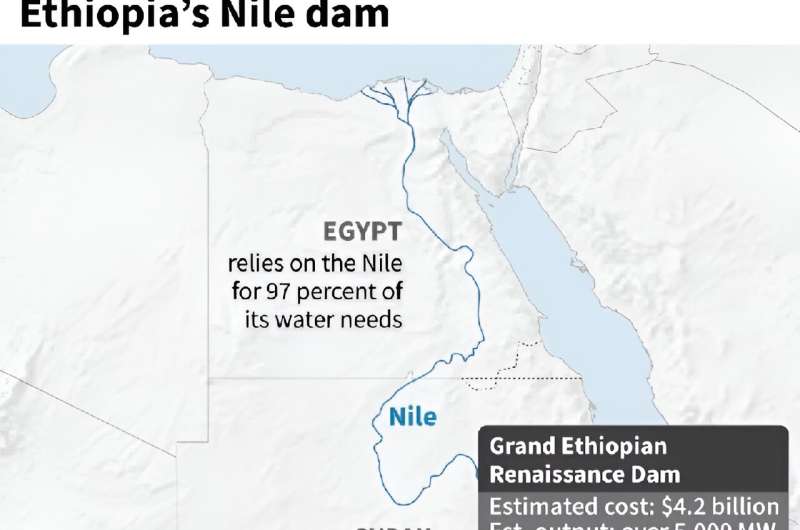This article has been reviewed according to Science X's editorial process and policies. Editors have highlighted the following attributes while ensuring the content's credibility:
fact-checked
reputable news agency
proofread
Ethiopia says mega-dam doubles electricity output

Ethiopia said it has more than doubled electricity production from its controversial mega-dam on the Blue Nile after two more turbines started operations.
The multi-billion-dollar Grand Ethiopian Renaissance Dam (GERD), long a source of tensions with downstream nations Egypt and Sudan, is now generating 1,550 megawatts of electricity, GERD said in a post on X late Tuesday.
"The overall progress of the GERD has now transitioned from construction phase to operation phase," it said, adding that construction of the concrete dam was now complete.
"The two turbines generating 400MW each have now started operations, adding to the already functional two turbines generating 375MW each, totalling an output of 1,550MW."
The dam's spillways were also releasing an extra 2,800 cubic meters of water to the downstream countries, it added.
Ethiopia first began generating electricity at the $4.2-billion project, which is located in the northwest of the country around 30 kilometers (18 miles) from the border with Sudan, in February 2022.
At full capacity, the huge dam—1.8 kilometers long and 145 meters high—could generate more than 5,000 megawatts of power when all 13 turbines are operational.

That would make it Africa's biggest hydroelectric dam and more than double Ethiopia's current output.
Addis Ababa deems the GERD essential for the electrification and development of Africa's second most populous country.
According to the World Bank, roughly half of the 120 million population still does not have access to reliable electricity.
Electricity deficit
The dam, which can hold up to 74 billion cubic meters of water, has been at the centre of a regional dispute ever since Ethiopia broke ground on the project in 2011.
Egypt and Sudan have voiced concerns about its operation without a three-way agreement, fearing it could threaten their access to vital Nile waters, but on-off negotiations have failed to make a breakthrough.
Egypt, which is already suffering from severe water scarcity, sees the dam as an existential threat because it relies on the Nile for 97 percent of its water needs.

The position of fragile Sudan, which is currently mired in a civil war, has fluctuated in recent years.
Ethiopia insists the dam will not reduce the volume of water flowing downstream.
"The Grand Ethiopian Renaissance Dam (GERD) plays a crucial role in managing water flow, mitigating flood risks, and ensuring that downstream nations receive a steady supply of water, particularly during droughts," Prime Minister Abiy Ahmed said in a post on X on Sunday.
In April, the World Bank announced a plan to help Ethiopia expand its electricity network and diversify into other clean resources, including solar, wind, and geothermal power.
It said the government had made "encouraging progress" on its electrification program and expanded the grid network coverage to nearly 60 percent of towns and villages.
"Yet the electricity deficit in Ethiopia continues to exacerbate the poverty situation, preventing far too many people from fulfilling their basic socio-economic needs and limiting access to opportunity," it said.
© 2024 AFP


















